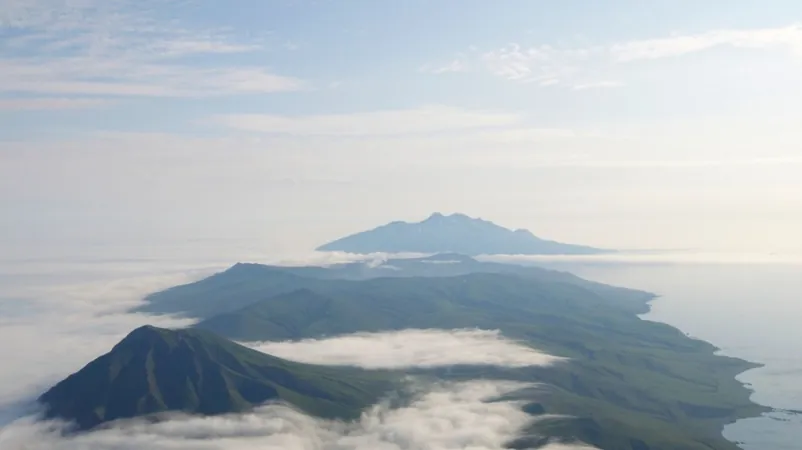
The Unveiling of a Climate-Chilling Eruption: Identifying the 1831 'Mystery Volcano'
2025-01-06
Author: Amelia
The Unveiling of a Climate-Chilling Eruption: Identifying the 1831 'Mystery Volcano'
In a remarkable scientific development, researchers have finally uncovered the identity of the infamous "mystery volcano" that erupted in 1831, an event that contributed to a global cooling phenomenon. This eruption, one of the most powerful of the 19th century, released vast amounts of sulfur dioxide into the upper atmosphere, causing average temperatures in the Northern Hemisphere to plummet by around 1 degree Celsius (1.8 degrees Fahrenheit). This eruption coincided with the tail end of the Little Ice Age, a notably frigid period lasting over 400 years.
For nearly two centuries, the location of the volcano remained an enigma, puzzling scientists and historians alike. Recently, researchers turned their attention to Greenland's ice cores, examining layers that revealed signs of volcanic activity, such as sulfur isotopes and volcanic ash deposited between 1831 and 1834. This investigation employed geochemistry, radiometric dating, and trajectory modeling to trace the volcanic particles' origin.
The findings pinpoint Zavaritskii Volcano, located on Simushir Island in the Kuril Islands archipelago, as the likely suspect. This region, claimed by both Russia and Japan, is somewhat obscure; historical records around Zavaritskii's activity were scarce, with the last known eruption recorded as far back as 800 BCE.
Lead researcher Dr. William Hutchison, from the University of St. Andrews, highlighted the challenges of studying remote volcanoes, stating, "Zavaritskii is situated on a desolate island with no permanent inhabitants and limited historical documentation." Before this study, many had erroneously attributed the 1831 eruption to tropical volcanoes, overlooking the possibility of a colder latitude culprit.
In an intriguing twist, the analysis showed that sulfur fallout in Greenland was significantly higher than in Antarctica, suggesting the eruption's geographical location was crucial to its impact. The precise matching of ash samples from Zavaritskii and those found in the ice cores confirmed the volcano’s role in this climatic episode.
This eruption did not merely affect temperatures but also had dire socio-economic effects. Following the event, the world experienced cooler and drier weather patterns that led to widespread famine across India, Europe, and Japan. Dr. Hutchison noted, “It seems plausible that volcanic climate cooling exacerbated crop failures, correlating with historical famines.” Further investigation might reveal how much these harsh conditions stemmed from the volcano versus other political and social factors of the time.
Interestingly, Zavaritskii’s resurrection as a significant player in volcanic history points to the potential of other remote volcanoes in the Kuril Islands to similarly impact the planet's climate. The study serves as a reminder that volcanic activity can have catastrophic global repercussions, especially since many of these volcanoes remain poorly monitored.
The implications are clear: the scientific community must enhance monitoring efforts for isolated volcanoes to better prepare for potential future climatic events. As Dr. Hutchison emphasized, it's vital to cultivate an international response strategy in the face of volcanic eruptions that could reverberate across the globe.
This groundbreaking research not only provides clarity on a past climatic mystery but also serves as a crucial alert for the future. Understanding the interplay between volcanic eruptions and climate could be central to addressing potential global challenges ahead.
Be sure to stay informed about further developments in climate science and volcanic research as they unfold!



 Brasil (PT)
Brasil (PT)
 Canada (EN)
Canada (EN)
 Chile (ES)
Chile (ES)
 Česko (CS)
Česko (CS)
 대한민국 (KO)
대한민국 (KO)
 España (ES)
España (ES)
 France (FR)
France (FR)
 Hong Kong (EN)
Hong Kong (EN)
 Italia (IT)
Italia (IT)
 日本 (JA)
日本 (JA)
 Magyarország (HU)
Magyarország (HU)
 Norge (NO)
Norge (NO)
 Polska (PL)
Polska (PL)
 Schweiz (DE)
Schweiz (DE)
 Singapore (EN)
Singapore (EN)
 Sverige (SV)
Sverige (SV)
 Suomi (FI)
Suomi (FI)
 Türkiye (TR)
Türkiye (TR)
 الإمارات العربية المتحدة (AR)
الإمارات العربية المتحدة (AR)